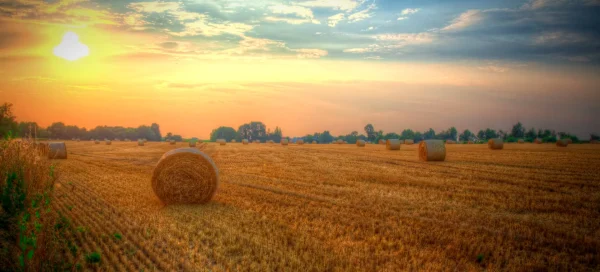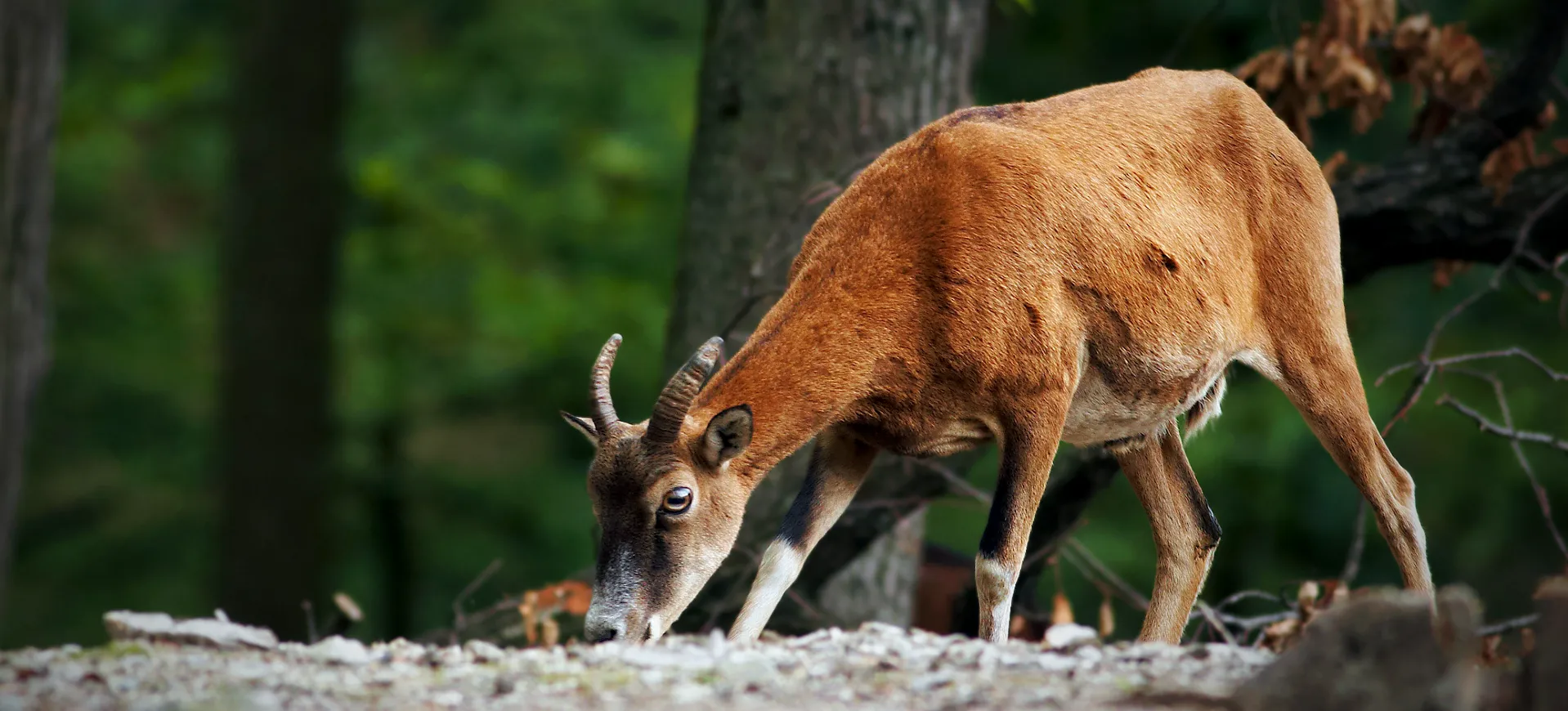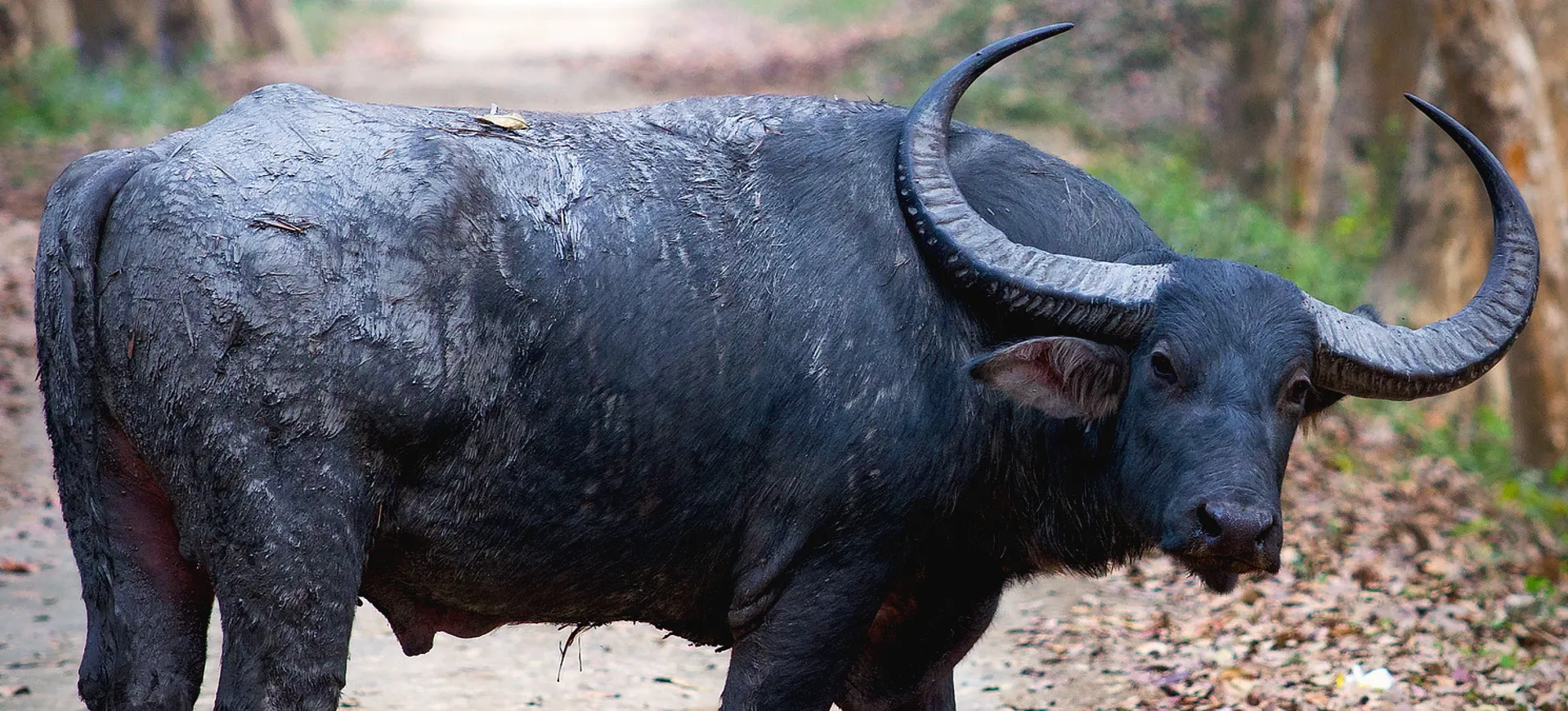Overview
The Domestic Yak (Bos grunniens) is a long-haired domesticated bovid found throughout the Himalayan region of the Indian subcontinent, the Tibetan Plateau, and as far north as Mongolia and Russia. It is characterized by its dense, woolly fur, which adapts to the cold environments in which it lives. Yaks are integral to the livelihood of the local populations, providing milk, meat, and fiber and being used for transport and agricultural work. They are known for their hardiness and ability to thrive at high altitudes, where other domesticated species might struggle to survive.
Yaks have a broad, sturdy frame with a pronounced hump over their shoulders, and males are significantly larger than females. Their horns, which both males and females possess, curve outwards and upwards and are used for defense and foraging through snow to find vegetation. The domestic yak has a variety of coat colors, ranging from black to brown to white. Their long hair hangs down the sides of their body, providing insulation against the cold.
Domestic yaks play a crucial role in their ecosystems by grazing on vegetation that other species cannot easily digest, thus maintaining the health of alpine and subalpine grasslands. They are also culturally significant to the communities that depend on them, featuring prominently in local traditions, festivals, and religious practices. Conservation efforts for wild yak populations indirectly benefit domestic yaks by preserving their natural habitats and genetic diversity.
Taxonomy
Kingdom
Phylum
Class
Order
Family
Genus
Species
Type
RANGE
Current distribution:
While the domestic yak is widespread across the Himalayas, the Tibetan Plateau, and surrounding regions, its wild counterpart, the wild yak (Bos mutus), is more restricted due to habitat loss and competition with domestic livestock. The domestic yak, however, has been introduced and adapted to various high-altitude regions beyond its original range, including parts of Mongolia, Russia, and Central Asian countries. These animals are primarily kept by nomadic herders, who move through the high-altitude grasslands following the seasonal availability of pasture.
In these regions, domestic yaks are not just livestock but are integral to the culture and economy of the local communities. They are bred for various purposes, including meat, milk, fiber, and as beasts of burden. The adaptability of yaks to various high-altitude environments has allowed for their successful integration into the agricultural practices of many high-altitude communities worldwide.
Physical Description:
Domestic Yaks have a distinctive appearance, characterized by their large size, long hair, and robust build. They typically measure about 5.2 to 7.2 feet in height at the shoulder and can weigh anywhere from 580 to 1,300 pounds for males, while females are smaller, weighing between 510 and 570 pounds. Their dense coat consists of a woolly underlayer and a longer, coarse outer layer of hair, which helps insulate them against the cold. A yak’s tail is bushy, resembling that of a horse, and their wide, flat hooves are adapted to walking on soft, uneven ground.
The coloration of domestic yaks varies widely, including shades of black, brown, white, and even piebald patterns. Their horns, curving upwards and outwards, are another distinguishing feature, which they use for defense and foraging under the snow. Yaks have small ears, a broad forehead, and a short, thick neck. Their eyes are positioned to provide a wide field of vision, an adaptation that helps them monitor for predators in their natural environment.

Lifespan: Wild: ~20 Years || Captivity: ~25 Years

Weight: Male: 580-1,300 lbs (263-590 kg) || Female: 510-570 lbs (231-259 kg)

Length: Male & Female: 78-132 inches (198-335 cm)

Height: Male & Female: 62-86 inches (158-220 cm)

Top Speed: 25 mph (40 km/h)
Characteristic:
Native Habitat:
Domestic Yaks are native to the high-altitude regions of the Tibetan Plateau, which offers a harsh, cold, and mountainous environment. This region is characterized by its sparse vegetation, rocky terrain, and thin air, under which yaks have thrived for thousands of years. The adaptation of yaks to these high-altitude conditions includes not only their physical characteristics but also their behavior, such as their social structure and grazing patterns.
Yaks prefer alpine meadows, grasslands, and areas near water sources, where they can find the vegetation they need for grazing. They are well adapted to live at altitudes of up to 15,000 feet, where oxygen levels are low and temperatures can drop well below freezing. The ability of yaks to thrive in these conditions makes them invaluable to the human populations of these regions, providing them with a source of livelihood that is well adapted to the local environment.
Climate Zones:
Biomes:
Biogeographical Realms:
Continents:
Diet:
Diet & Feeding Habits:
Domestic Yaks are primarily herbivores, grazing on grasses, herbs, and other alpine vegetation. Their diet is adapted to the high-altitude environments in which they live, where vegetation is sparse and often covered in snow. Yaks have a unique stomach structure that efficiently processes their fibrous diet, extracting maximum nutrients. This digestive adaptation is crucial for surviving the harsh conditions of their natural habitats.
In addition to natural forage, domestic yaks are often provided with supplementary feed by their herders, especially during the winter months when natural vegetation is scarce. This may include hay, grains, and other nutrient-rich feed to ensure their health and productivity. Yaks also require access to water, and they can often be seen grazing near streams or lakes. Their feeding behavior is adapted to their environment, with yaks moving to higher or lower altitudes depending on the season to find suitable grazing.
Mating Behavior:
Mating Description:
The mating season for domestic yaks typically occurs in the late summer to early fall, during which males become more aggressive and compete for access to females. During this time, males will display a range of behaviors to attract females and assert dominance, such as bellowing, head tossing, and mock fighting. Females prefer dominant males, who are more likely to sire offspring.
Yaks have a gestation period of about 9 months, with most births occurring in the spring. This timing ensures calves are born into a season where the weather is milder, and food is more plentiful, increasing their chances of survival. A female yak usually gives birth to a single calf, nursed for about one year. Calves depend highly on their mothers during the first few months of life, staying close to them for warmth and protection.
Reproduction Season:
Birth Type:
Pregnancy Duration:
Female Name:
Male Name:
Baby Name:
Social Structure Description:
Domestic yaks exhibit a social structure influenced by their environment and the needs of their herders. In the wild, yaks are known to form herds consisting of females and their offspring, with males either living solitarily or forming smaller groups. Domesticated yaks maintain a similar social structure, with herds typically led by a dominant female or bull. These herds are cohesive units that move together in search of grazing.
The social hierarchy within yak herds is established through displays of dominance and submission, with access to resources such as food and mates being influenced by an individual’s rank. This social structure plays a crucial role in the management and welfare of domestic yak populations, with herders often using knowledge of yak behavior to organize and control their herds. Social bonds among yaks, particularly between mothers and calves, are strong and essential for the survival and well-being of the individuals within the herd.
Groups:
Conservation Status:
Population Trend:
The population of domestic yaks is stable and widespread across the high-altitude regions where they are raised. They are considered an essential asset to the local communities, providing a source of milk, meat, and fiber and being used for transport. The health and productivity of yak populations are closely monitored by herders, who use traditional breeding practices to maintain their herds’ genetic diversity and vitality.
Despite the stable status of domestic yak populations, climate change, overgrazing, and competition with other livestock could impact their future. Efforts to sustain yak populations focus on sustainable herding practices, preservation of traditional knowledge, and adaptation to changing environmental conditions. These strategies are crucial for ensuring the continued viability of yaks as a resource for high-altitude communities.
Population Threats:
The primary threats to domestic yak populations include habitat degradation, climate change, and competition with other domestic species. Overgrazing and the encroachment of agricultural land into traditional grazing areas can reduce food availability for yaks. Climate change poses a significant threat by altering the ecosystems of high-altitude regions, potentially reducing the quality and quantity of pasture available for grazing.
Additionally, diseases transmitted from other domestic animals and the potential for inbreeding in small, isolated populations can affect yaks’ health and genetic diversity. Efforts to mitigate these threats focus on sustainable grazing practices, disease management, and the maintenance of genetic diversity through careful breeding practices.
Conservation Efforts:
Conservation efforts for domestic yaks largely focus on sustainable herding practices and preserving traditional knowledge among the communities that depend on them. Programs aimed at improving the health and productivity of yak herds include veterinary services, breeding programs to maintain genetic diversity, and initiatives to enhance the market value of yak products. These efforts support herders’ livelihoods and ensure the sustainable use of natural resources.
International cooperation and research into the adaptation of yaks to changing environmental conditions are also crucial components of conservation efforts. Projects that aim to understand and mitigate the impacts of climate change on high-altitude ecosystems can help secure the future of yaks and the communities that depend on them. Conservationists aim to create a sustainable future for domestic yaks by combining traditional knowledge with modern science.
Additional Resources:
Fun Facts
- Yaks can produce sounds that include grunts and snorts, which is unusual among bovids and a characteristic that has led to their scientific name, Bos grunniens, meaning “grunting ox.”
- The milk of a yak is rich in fat and protein, making it a valuable food source, and is used to make butter, cheese, and other dairy products.
- Yaks have larger lungs and hearts than other bovines, adaptations that allow them to live at high altitudes with low oxygen levels.
- The wool of a yak is extremely warm and soft and highly valued for making clothing and blankets.
- Domestic yaks can carry heavy loads across difficult mountainous terrain, making them indispensable to human owners.
- Yaks bathe in dust or mud to maintain their skin and coat health, a behavior known as dust bathing.
- The local communities commonly use A yak’s dung as a fuel for fires due to the scarcity of other fuels in their high-altitude habitats.
- Yaks have a unique digestive system that efficiently breaks down tough, fibrous plants that are indigestible to many other animals.
- The natural predation pressure on domestic yaks is relatively low due to their large size and protective herding behavior.
- Yaks play a significant role in the culture and economy of the Himalayan and Tibetan Plateau regions, including being featured in festivals and traditional ceremonies.

















































































